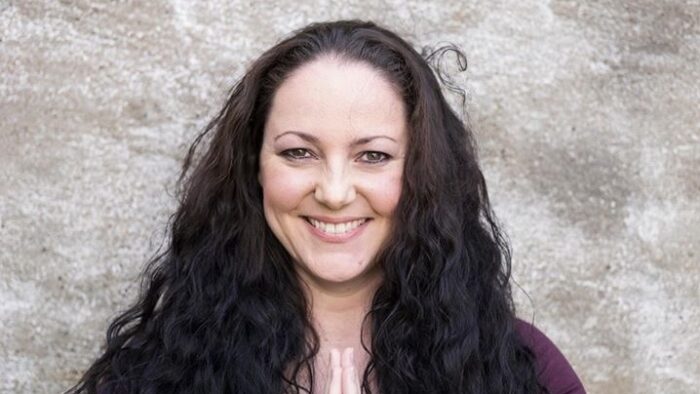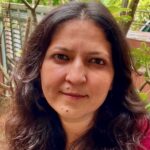Says Sanja Wieland as she felt she heard herself for the first time while practising mantras. She tells Veda Studies’ Sophie French about the many ways in which Veda recitation affected her body-mind-intellect.
In his book Sonic Theology: Hinduism and Sacred Sound, scholar, author, musicologist and historian of religions, Guy L. Beck, states that, “The function of oral language as an agent of transformation from the human realm to the divine has been a perennial concern of Indian theological speculation, since language in Hinduism is nearly always identified with both human consciousness and the divine. This transformative aspect of language finds a firm foundation in the ancient Vedic tradition of ritual recitation.” Reiterating this fact, Germany-based yoga teacher and student and teacher of Veda recitation, Sanja Wieland, shares her first experience of hearing sound in the form of mantra and how it affected her. “When I was attending a Yoga Teacher Training at the Sivananda Ashram in Germany, our teacher was making the students hum sounds to open the chakras and when we reached the throat chakra or Viśuddha chakra, I felt a deep opening or sorts. I don’t know how to describe it but I remember it so clearly even now. I was so overwhelmed and this was the moment I realised I had a voice (laughs) and I realised how much Sanskrit can do.”
Sanja’s first experienced yoga in asana form as a child. She has old photos of her mother and her practising yogic postures and at the time, she had no clue that these exercises she was doing with her mum were yoga asanas. She became more familiar with asana practice while at university and even though she didn’t grow up in a spiritual or religious home, she was always looking for it. “There was something calling me and I was looking around and I was sent to a Christian kindergarten and then to another Christian school and I was looking into various ways to find spirituality. I loved going to churches but just somehow, I didn’t find a connection. Then I decided to go deeper into yoga and I found the integral teachings of yoga that are beyond asana and that’s when I finally felt like I was home. I fell in love with Sanskrit and fell in love with mantras. I’ve been following that path for 18 years now,” says Sanja.
Sanskrit: Knowing vs. Practising
When I started reciting Veda under the tutelage of the founder of Veda Studies, Shantala Sriramaiahji, I had no idea what to expect. I had heard numerous bhajans and kirtans and like Sanja, I too have spent time at an ashram and at various temples but until Veda Studies, all mantra sounded like singing or chanting to me. It is only when I started reciting Veda that I began to understand the difference between kirtan, bhajan, singing, chanting and reciting.
All of the above employ Sanskrit and are an act of devotion but what makes Veda different is the rules applied to recitation. The first thing we learn in Veda Studies are the six rules of Veda recitation. These are Varṇaḥ, Svara, Mātra, Balam, Sāma and Santāna. This nuanced understanding of Veda recitation drew Sanja (and even me) deeper into study. Sanja began to grasp the subtle effects of reciting Sanskrit and the importance of the śruti parampara (oral tradition). “The first time I heard Sanskrit, it really resonated with me but I didn’t know the difference between Sanskrit and Vedic chanting, even though it is Sanskrit (laughs). I mean I had studied Sanskrit, I knew the text and pronunciation but the Sanskrit of the Veda expanded my understanding to another level. I mean even within Veda recitation, there are different traditions and lineages and each have their own rules and to understand just how vastly profound Sanskrit is, one has to learn to practise Veda recitation and this door was opened to me when I started studying with Shantala and Veda studies, says Sanja.”
She has been studying with Shantalaji for over two years and even did the Indica Veda Studies Teacher Training Programme in 2023. Speaking of how recitation has affected her spiritual practices, Sanja says that, “When I first started chanting, it wasn’t Vedic chanting. I had done my Yoga Teacher Training at a Sivananda ashram in Germany and at the time, I was more oriented towards kirtans and bhajans so it wasn’t strictly Veda recitation. When I started studying with Veda Studies and recited Veda with the rules of recitation, I was being exposed to the root and the source of where all Indic knowledge came from. I found the core of the mantra — I love the sounds, I love how they make me feel and reciting mantras even enhances my yoga classes because now even my students experience spirituality in a more wholesome way. I recite to them and I share stories with them about Vedic deities and how to apply all that to their spiritual progress. It also made me more intuitive to sound — the quality of sound and also the quality of silence that is felt after reciting — and in a way mantra recitation has become my main yoga or rather spiritual practice. That was the transformation — I started to understand how to live the philosophy and feel it through the sound of Veda. I understood how to turn the deep resonance of sound into a daily ritual and I am grateful that I am able to share this with my family and students. This is how Veda recitation changed my practice and my teaching at all levels.
Bhārata: The Source of Indic Knowledge
Bhārata is vast and ancient and is one of those places where the past, present and future exist simultaneously. It is evident in the architecture in the cities where the ruins of the past lean against high rises of the future, where ancient temples reside next to modern malls and where you’ll hear temple bells at home every morning during aarti and a few hours later, Hip-hop is belted out of the same home. India’s mystique is in her contraries. Sanja’s relationship with India wasn’t love at first sight. It took a while for her to fall in love. “My father worked in India for several years and I first went to India when I was 16 and frankly, I hated it (laughs). It was just too much for me as a teenager and I swore never to return to India. Then after I started practising asana, I remember I told my dad that I am willing to visit India again but on the condition that I get to go to an ashram as well. My dad had no idea what an ashram was but he said he would try to organise this and he organised a stay for me at the Osho ashram in Pune. I had no idea about this place or what happened there and I was so overwhelmed when I got there but ended up visiting at least eight times. Now, India feels like home. I feel there is a spiritual daily-ness in India — there is always a temple around the corner, there is God in every store, there are altars everywhere so God is prominent everywhere in India. This really moved me about India because here in the West, there is religion but it is confined and it is not not everywhere and that’s what makes India different. In fact, I know that not everyone in India is practising dharma but it is always there and always available for when one is ready and that one can be anyone. God is always accessible in India and I love that,” says Sanja.
Her advice to Westerners coming to seek spirituality in India is, “Know and research where the knowledge is coming from and be true to the lineages that you follow. Be aware of the different lineages so you can understand that there is no such thing as just one type of school or yoga or system. Don’t limit yourself like that. Find the path that suits you and then stay true to that. And of course, always remain a student, even if you become a teacher.”
For further information, follow Sanja on @sanja.wieland





